Environmental Sciences & Natural Resources - Juniper Publishers
Abstract
The knowledge of the impact of crude oil contamination is important for effective and sustainable environmental conservation. 20kg of plough layer soil was bagged and arranged in a complete randomized design. Crude oil at seven treatment rates of 0, 10, 20,30,40,50, and 60ml replicated thrice were poured, mixed, and allowed for two weeks before corn was planted. The experiment lasted for 3 months. Soil samples collected before and after the study were analyzed using standard laboratory methods. Maize growth parameters were collected at 4, 8, and 12 weeks after planting (WAP) respectively. Generated soil and plant data were subjected to analyses of variance (ANOVA). Results showed significant (P < 0.05) increase in bulk density, moisture content, pH, organic carbon with increasing rates of pollution. At 12 WAP like other intervals, leaf area index, plant height, dry matter yield in crude oil polluted soil were lower than the control.
Keywords: Crude oil spillage; Environmental pollution; Soil sustainability; Maize growth; Food security
Introduction
Crude is unrefined oil found underground [1] that is majorly composed of a complex mixture of hydrocarbons, metals, and organic compounds in their variants. These products are of particular concern to studies of pollution due to their none, little, and slow biodegradability potential and serious health implications associated with its release into the environment. Man’s activities connected with crude oil refining have their pecuniary impacts on the locality. Crude mining through exploration and exploitation often leads to oil spillage [2], affecting the ecology [3] hence a chief source of environmental stress [4,5] notably in countries that produce oil such as Nigeria [6].
Notable adverse effects of crude oil on soil include hampering soil physical processes by the sealing and clogging of pore spaces which limit aeration and infiltration rate, root restriction, and overland flow of water through an increase in bulk density. Other affected physical and chemical soil properties are saturated hydraulic conductivity and water permeability [7], soil acidity, total nitrogen, heavy metal concentration, exchangeable cations, and organic matter content [8]. In crops, significant harm on the physiological functioning [9] brownish/yellowish vegetation [10], reduced crop biomass [11], stunted growth, leaf chlorosis, and plant dehydration [12] have been reported. Oil spillage according to [13,14] affect the germinability of plants by forming a film that prevents oxygen from entering the seed [15] and masking the conditions that make plant important nutrients available [16,17]. Underground water quality [3] and aquatic lives were not in exception [9].
Corn or maize, belonging to the family of grasses known as Poaceae took its origin from Mexico [18]. It is morphologically stout, erect with a solid stem, and has the leaves arranged on the opposite side of the stem in alternate positions [18]. According to [19] the wide environmental adaptability, human and animal food/feed, and income generation [20,21]) made Zea mays L. the most important cereal next to rice and wheat grown in the world. The production of maize is masked with many constraints especially nutrient deficiency. Despite the global maize production projected to increase by 181Mt in 2028 [22] to feed the increasing human population expected to hit 8.5 billion by 2030 [23] the need for more maize production will continue to grow especially in upcoming countries [24]. This accounts for why [20], predicted more than 60Mt of corn to meet global demand. The competing demand for maize by animals will continue to put pressure on maize production [25].
Soil, the most valuable but vulnerable ecosystem component sustainable use is at risk today. Studies on the lethality of crude oil spillage on the soil are majorly based on onsite field studies, but the high-security challenges on oil spill sites and nearby farms made holistic researches very difficult. Knowledge is a continuum and efforts made to update existing information especially on agriculturally endangered zones are highly needed. Due to the above reasons, this work is mainly aimed at determining the effects of crude oil contamination on properties of soil and growth parameters of maize (Zea mays L.). Specifically, the study determined:
i. crude oil contamination on soil physical and chemical properties, growth parameters of maize in pot and on field experiments.
ii. Comparisons were made between selected results of both experiments with those at the initiation of the study.
Materials and Methods
Study area
The research was done at the Center for Agricultural Research and Extension (CARE) garden of the Federal University of Technology Owerri, Nigeria which is located on latitude 5021’ N and 5028’N and Longitude 7011’E and 7045’E. The soil, classified as Typic Isohyperthermic Peleudult [26] belongs to the Beni formation geological group [27,28]. They are characterized with high weatherability and leaching, low organic carbon content, low in exchangeable cation, and high acidity [29]. The average annual rainfall, temperature, and relative humidity are 2500-3000mm, 27-30, and 79% [30]. The original tropical rain forest vegetation is now replaced by secondary forest as a result of anthropogenic activities and an increase in the human population. The major occupation of the inhabitants is farming where maize, cassava, cocoyam, and yam are the major crops produced.
Soil collection and contamination
Surface soil samples (0-15cm depth) were collected with the standard procedure of soil sampling. 20kg of the collected samples were bagged and arranged on the farm in a complete randomized design. Crude oil (Bonny light) sourced from Agip Nigeria at seven (7) treatment rates of 0, 10, 20,30,40,50, and 60ml were poured in each plot respectively. Each treatment was replicated thrice making a total of 21 plots or bags used. The bags were perforated to allow drainage of excess water from the bag. Two meters away from where the bags were placed field experiment was established on an area of 99.225m2 (15.75 X 6.30m) representing 0.00925ha. The essence for establishing both experiments in the same place was to make sure that they receive the same climatic variables such as rainfall, temperature etc).
Firstly, the area was cleared and later minimally manipulated or tilled. Also 21 plots now in Randomized Complete Block Design were established. Crude oil at the same rates and replicates above was poured directly around the tilled area. Both experiments were simultaneously monitored for two weeks before planting took place. Maize accessions used for the study was sourced from Agricultural Development Program (ADP) office Owerri. Three (3) seeds were planted per hole at an intra-row spacing of 0.25m and inter-row spacing of 0.75m and later thinned down to one plant per hole at three weeks after planting giving a theoretical plant population of 33,333 plants per hectare. Planting was done on the 13th of May, 2019 during the 2019 cropping season. Agronomic practices were also carried out in both studies.
The reason for establishing both experiments above were to determine if pot experiments results could be substituted to field results especially in high security challenge areas. Again, the comparison of pot experiments results to those of field conditions are limited.
Data collection procedure
Growth factors of maize were collected at 4, 8, and 12 weeks after planting (WAP). The height of the plant was taken from the base to the terminal bud with a measuring tape. Leaf area index (LAI) was measured by multiplying the length (L) and width (W) of the longest leaf in each plot with a 0.75 correction factor for maize (L X W X 0.75) as was prescribed by [31] Dry matter yield was achieved by harvesting the leave and stem of the maize plant at maturity and air drying them for one week after which they were weighed. Plant structural efficiency was calculated by dividing dry matter yield with the leaf area index. Soil samples to be analyzed in the laboratory were taken at the end of the experiment.
Laboratory analyses
Soil analyses at both the initiation of the study (before the study commenced) and after pollution were determined following the standard procedure of the documented researchers as follows: Particle size fractions [32], bulk density [33], total porosity [34], soil moisture content [35], pH in water [36], organic carbon [37], total nitrogen [38], available phosphorus [39], exchangeable acidity, sodium and potassium [40], calcium and magnesium [41], effective cation exchange capacity (ECEC) [34] respectively.
Data analyses
Generated plant and soil data were subjected to analysis of variance (ANOVA) to detect significant differences between treatment means and Fisher’s least significant difference (F-LSD was used for mean separation at 5 % level of probability.
Results
Physical properties of the studied soil following crude oil pollution
Results of the physical properties of studied soil following crude oil pollution are presented in Table 1. Crude oil pollution did not significantly (P< 0.05) affect particle sizes in the pot and field experiments, however individual percentage fractions changed, a result similar to [42]. In both studies, sand and silt fractions increased with an increase in rates of application. Sand, silt and clay fractions varied from 738.10, 120.42, 141.48g kg-1 at control (zero pollution rate) to 764.02 ,135.06; 100.92gkg-1 at 60ml pollution rate in the pot experiment and 741.34 ,122.34, 136.32gkg-1 at control (zero pollution rate) to 760.16; 139.22; 100.62g kg-1 at 60ml pollution rate in field experiment. Bulk density, which was significantly (p < 0.05) affected by crude oil pollution in both studies progressively increased with an increase in rates of pollution. [43,14] found higher bulk density values in soil polluted with crude oil.
Bulk density ranges from 1.42gcm-3 at control (0 pollution rate) - 1.67gcm-3 at 60ml pollution rate in the potted experiment and from 1.34 - 1.69gcm-3 at the same pollution rates in the field studies (Table 1). It is note-taking that oil pollution raised bulk density above the 1.2gcm-3 critical level for tropical soils documented by [44] to 1.69gcm-3 which is for soils with high compaction characteristics, low structural development, and high cohesion [45]. A comparison of bulk density values (Figure 1) after crude oil pollution to those of the initial values (before the commencement of the work) in Table 2, still emphasized the impact crude oil has on the soil. Moisture content differed significantly (P<0.05) with the rates of crude oil pollution. The highest 745.93gkg-1 and lowest 450.35gkg-1 values (pot experiment), 778.33 and 452.32gkg-1 (field experiment) occurred at 60 and 0ml (control) pollution rates respectively. [14,46,47] found higher moisture content in soils spilled with oil than unpolluted soils. The impact of crude oil pollution on moisture content was higher in the pot experiment compared to the initial values (Table 2) and those on the field (Figure 1).
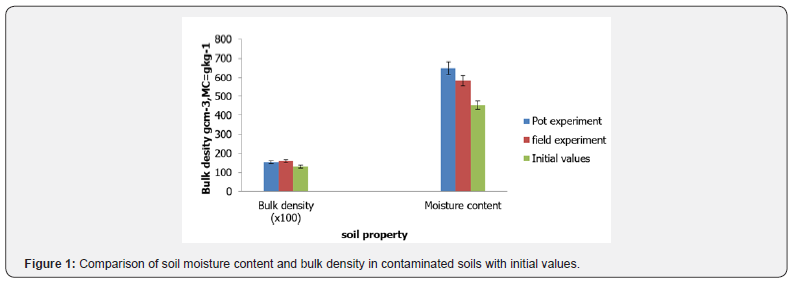
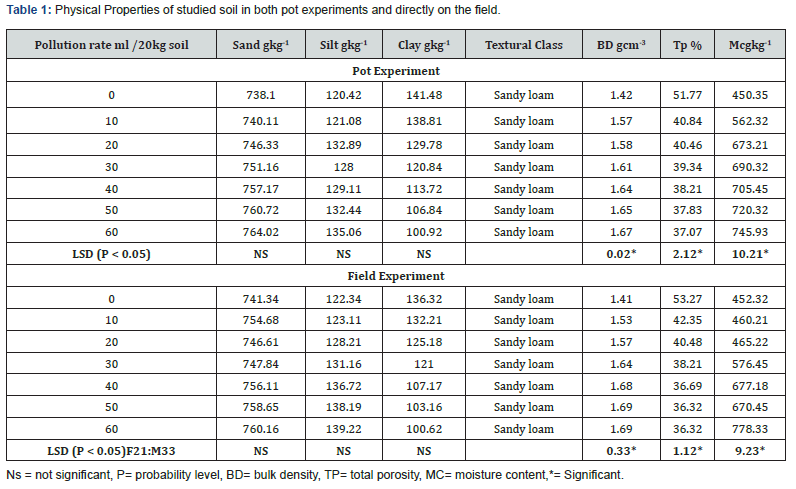
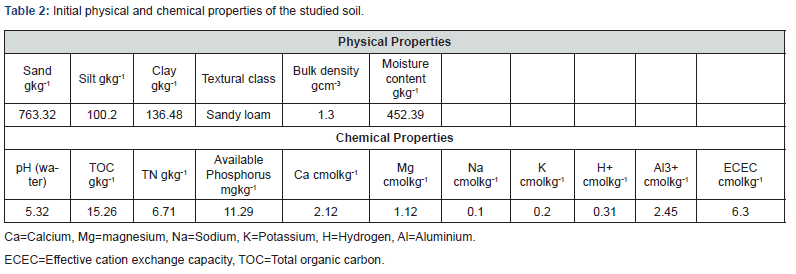
Chemical properties of the studied Soil following crude oil contamination
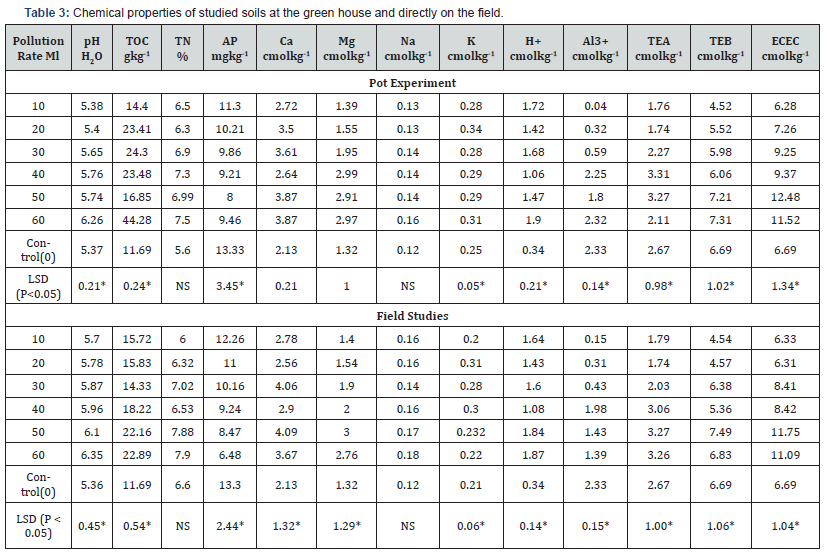
The results of the chemical properties of the studied soil are presented in Table 3. Soil pH (H2O) differed significantly (P < 0.05) among the levels of pollution in both the field and pot experiments respectively. In a progressive manner, soil pH tended towards alkalinity from 10ml (5.38 and 5.70) to 60ml (6.26 and 6.35) in experiments conducted in the pot and directly on the field respectively. The results were higher than the respective control values of 5.36 and 5.37. Soil organic carbon ranged from14.40 gkg-1 at 10ml to 44.28gkg-1 at 60ml pollution rate in pot experiment and from 14.33gkg-1 at 30ml to 22.89gkg-1at 60ml pollution in the field experiment. The result of the experiment is in agreement with [48]. Results showed that soil organic carbon increased with increasing rates of oil pollution except at 50ml pollution rate (16.85gkg-1) on the pot experiment and 30ml pollution (14.33gkg-1) on field experiment. [3,43] found progressive higher values of organic carbon following an increase in the rates of crude oil pollution in a soil. Total nitrogen of the studied soils though not significant at 5% probability level in both studies ranged from 5.60 to 7.50gkg-1 in pot experiment and from 6.0 to 7.90gkg-1 at 10ml and 60ml pollution rates in field studies.
The high values of total nitrogen in polluted soils were similar but higher than those of [47] in the same area who obtained total nitrogen values ranging from 2.80gkg-1 in unpolluted soils to 3.40gkg-1 on soil polluted with spent engine oils. Available phosphorus markedly decreased with an increase in the rate of crude oil pollution in both studies. Critical limits of available phosphorus determined by [39] method in soil varies from high (> 15mgkg-1), medium (15-5mgkg-1) and low (< 5mgkg-1) [44]. Based on the above, the results in the present study were medium 9.21-13.33mgkg-1 at 40 and 0ml pollution rates in pot experiment and 6.48-13.30mgkg-1 at 60 and 0ml (control) pollution rates. Total exchangeable bases (TEB) presented in Table 3 differed significantly (P < 0.05) in both pot and direct field experiments. They ranged from 4.52 - 7.31 at 10 and 60ml pollution rates in the potted experiment and 4.54 - 7.49cmolkg-1 in 10 and 50ml pollution rates in field studies. There was a progressive increase with an increase in pollution rates from 10 to 60 ml pollution rates in pot experiments. The results in the field were inconsistent with increase in oil pollution rates. Result increased up to 30ml pollution rate (4.54-6.38cmolkg-1) dropped at 40ml (5.36cmolkg-1), increased at 50ml pollution rate (7.49cmolkg-1) and dropped again at 60ml pollution rate (6.83cmolkg-1). In a comparison of the results obtained in pot and field experiments to those of initial soil samples, soil organic carbon, total nitrogen and effective cation exchange capacity were higher in pot experiment than those of field and initial values (Figure 2).
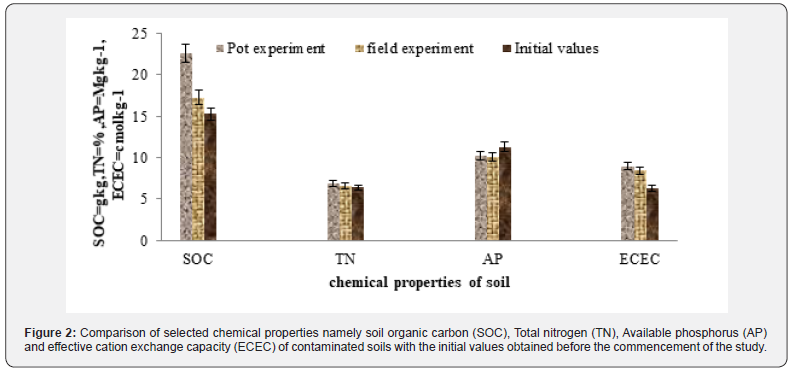
Effect of crude oil pollution on maize parameters
The results of the effects of the levels of crude oil pollution on plant height in both experiments are presented in Figure 3. The result showed a progressive reduction of plant height with increased levels of crude oil pollution. This continued as the weeks progressed from 4 to 12 after planting on field experiment. The same trend in pot experiment was observed except for results at 10 and 20ml pollution rates where there was an increase in plant height. Generally, plant height ranged from 20.60 cm at 60ml in 4WAP to 209.44cm ml at control on pot experiment and from 21.44cm to 239.4 cm at the same levels of pollution on field studies respectively. [21], reported maize plant height values ranging from 33 to 199cm at 4 and 8 WAP following crude oil pollution. These recorded values in height are far below 0.6m (600cm) height of matured maize as documented by [49]. The impact of crude oil on leaf area index, structural efficiency, and dry matter yield are presented in Figure 4 & 5 respectively. Leaf area index (LAI) significantly (< 0.05) differed among treatments means in both studies. The LAI was higher under control than in polluted soils which also decrease with an increase in the rate of pollution. Values ranging from 43.66 -342.98cm2 and 53.44-376.44cm2 were recorded at 60ml pollution rate at 4WAP and control at 12 WAP under pot and field experiment respectively (Figure 4). Dry matter yield took the same trend with the leaf area index only (Figure 5). The values were higher in the control 0ml than in polluted samples. The dry matter yield and leaf area index also affected the structural efficiency in Figure 5.
Discussion
The Increased values of sand and silt fraction with the increased rate of oil pollution in the field were similar to those of [50]. Similarly, [14,7] found higher values of sand and lower clay fractions in unpolluted soil than in polluted soils. This could be caused by the concentration of the applied crude oil as [51] opined that crude oil above 3% concentration can mask the effectiveness of soil and crop. An increase in sand fraction may lead to an increase in pollution of underground water through the migration or infiltration of acrylamide [52,53] a component of crude oil into the soil [14]. Increased in silt fraction in comparison to those of zero pollution rate is attributed to soil compaction caused by the oil [50]. Despite the rates of crude oil pollution, the soil texture remained unchanged. This confirmed [34] who documented that soil texture cannot be changed easily. The textural classification of the studied soil was in line with [54] who opined that the texture of the surface horizon of soils of the humid tropics is dominated by sandy loam and loam. The high bulk density as a result of oil pollution is attributed to the gelatinous and lower emulsifying nature of crude oil [48]. [55] reported that oil in soil increases the weight thereby causing more stress to it. This development alters other properties like pore size distribution, aeration, and soil strength and as well may alter the free movement of microorganisms, water, nutrients in the soil and as a result affect the overall development of the crop through root restriction. Total porosity followed the same trend with bulk density. This report agrees with the observation of [56], who reported that an increase in bulk density is associated with decreased pore volume.
The reduced pore space may create an anaerobic condition for soil organisms which can lead to their death. This may be the reason why [48,53] attributed the change in the microbial population, enzyme structure and system, and death of organisms to oil pollution. This higher bulk density in field experiment compared to those of pot and of the initial values could be traced to land use, the surface area of the soil which may have affected the dissemination of oil and tillage effects compared to those in the pot. Higher moisture content following increased rates of crude oil application is attributed to low infiltration within the soil as a result of the high bulk density created by the pollution. The amount of organic carbon and its binding effects on soil aggregates increases the water retention of soil. The importance of moisture in soil cannot be overemphasized especially in nutrient release to plant, spark in activities of microorganism, and crop growth. High water content could be attributed to less evaporation of water to the atmosphere due to the coating and clogging of soil pores as a result of its hydrophobic nature. The higher moisture content in pot experiment could be attribution to low moisture loss to the atmosphere as a result of bagging.


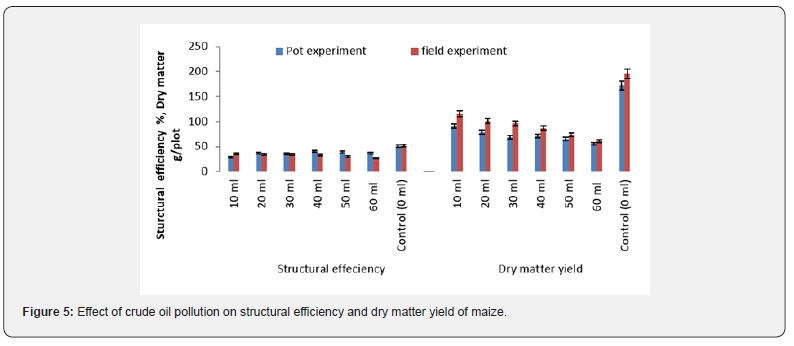
Our findings on soil pH were in disagreement with [14] who found lower values of pH with oil contaminated soil and the postulations of [57,58] that crude oil pollution could lead to lower values of soil pH. On the other hand our results strongly support [50] who found increase values of soil pH from 5.64 in control to 5.87 at 1000ml/20kg soil in soils of Cross River State Nigeria, [42] in working is soils of Romani, [46] on soils of China and [97] in China. [59] opined that soil pH values increases slightly with increasing values of oil treatment. These results were still acidic despite the increasing levels of pollution confirming the acidic nature of Isohyperthermic Typic Paleudult a factor attributed to parent material, high rainfall status of the area that leaches out soil basic cations [44] while leaving hydrogen and aluminium otherwise known as total exchange acidity [60] on soil surfaces. However, by raising the already acidic nature of the soil towards basicity, the oil must have modified the soil by activating basic cations notably calcium and sodium ions [61,8] which push upward soil pH by increasing the ionic stability. Similarly, the carbon and nitrogen content of crude oil can change the components and structure of soil organic matter to affecting the soil pH, electrical conductivity and C/N ratio of the soil [62]. The hydrophobic nature of crude oil might have a way of creating potential drought [63,64] on crude oil polluted soil surfaces. This makes the soil saline to an extent, a condition caused by high pH values in oil-polluted soils. [44] rated pH from 5.2 to 6.2 as moderate, while those from 6.2 - 6.9 are rated weakly acidic. It is interesting to know that the pH ranges were still in the range for optimum performance of crops and microorganisms in soil all things being equal. The increased values of organic carbon are achieved through an oxidative coupling process as a result of long decayed components of plants and animal debris [65] of crude. The slow decomposition rate as a result of the adverse effects of crude oil on soil microbes could be another possible cause. According to [41] ratings of soil organic matter in tropical soils, all results both in polluted and unpolluted soils fall within the very low (< 2% or 20 gkg-1) and low (2-4% or 20-40gkg-1) category. This is typical of humid tropical soils which have been reported to be low in organic carbon.
Organic matter calculated from of organic carbon [34,66] plays an important role in improving soil physical, chemical, and biological properties. It has been reported that organic matter as a dynamic soil property [67] has influences on the soil pH, water holding capacity [34], colour, cation exchange capacity, base saturation and buffering capacity [68] and effective cation exchange capacity [69]. The colloidal property [70] of soil organic matter justifies its binding effects on soil aggregates stability, and infiltration of soils. However, these influences may be masked in soils due to the mutagenic property of crude oil. Higher values of soil organic are attributed to crude oil pollution and land use by [71]. Furthermore, the increased values of total nitrogen are attributed to the impact of crude in promoting organic carbon content of the soil. [67,66,72] found a significant positive relationship of organic carbon with total nitrogen in soils. These results affirm the results of [50,73,74] but disagree with [75,76,77] who documented a decrease in total nitrogen with an increase in crude oil-polluted soil. The differences in total nitrogen following crude oil pollution compared values obtained by [47] could be attributed to the viscosity, density, and quality of the crude oil used to that of spent or condemned motor oil. [78] categorized total nitrogen content that is less than 2.5gkg-1 (0.25%) which is typical of humid tropical soils [44], as being low. These results were a little higher than the critical level of total nitrogen for optimum crop production in soils of humid tropics documented by [79]. Adequate nitrogen levels in the soil help to increase the vegetative growth of the plant.
Available phosphorus together with nitrogen and potassium are the three most important macro elements that are highly needed in the soil for optimum crop production [80]. These important soil properties especially phosphorus is always having fixation problems due to the high acidity of humid tropical soils [81] and its availability therefore must be supported or aided with mineral fertilizer [44]. Phosphorus availability in soil indicates the proper photosynthetic ability of crops, proper root growth, firm stem stalk, early maturity, and flower coloration whereas its inadequacy implies impaired root growth, colouring of lower leaves of plants, etc [81]. Reduction in available phosphorus which affirmed the works of [47,50,74,76] cut short the possible expectation of an increase in phosphorus availability due to the increase in soil pH, soil organic carbon and nitrogen content following increased rates of oil pollution. The complex process of phosphorus dissolubility in soils could be the reason and in such cases available phosphorus form of (H2PO4-) in soil [34] are converted to unavailable forms of H2O42- and PO43- [82] thus making phosphorous availability in soils very limiting [83]. The higher values of available phosphorus without pollution in Figure 2 confirmed the masking effects of crude oil on phosphorus availability.
On its own, the increased values of exchangeable bases with an increase in oil pollution are attributed to an increase in pH, organic carbon of the soils with oil pollution. Our results contrasted [84,85,76] who obtained a decrease in exchangeable bases with an increase in oil pollution. Results revealed the dominance of exchangeable calcium to magnesium, sodium, and potassium in studied soils which followed similar trends with total exchangeable bases. This is a strong indication that the studied soils were highly weathered [86]. Despite the increased values of Ca2+, Mg2+ and k+ following oil pollution, the values were still low in soils. [44] documented Mg < 30cmolkg-1 to be low, K that is between 0.2-0.30cmolkg-1 low, Ca <10 =low. Based on the ratings there is a possibility of crop yield reduction through poor stem growth, discoloration of leaves, wilting in case of potassium [34]. Total exchangeable acidity as a function of the hydrogen and aluminium content of the soil was inconsistent with increased rates of crude oil pollution in both studies. It ranged from 1.74 to 3.31 in pot experiment to1.74 to 3.27 in the experiment conducted directly on the field. The above result is caused by the relationship existing between soil pH, organic carbon, and exchangeable acidity [87].
The reduction in plant height supported the findings of [74,89,12,90] who reported reverse trends in plant height with an increase in crude oil pollution on aerial yam (Discorea bulbifere L.). This reduction is as a result of the adverse effects of crude oil in masking the release of nutrients in soil despite the higher value of organic carbon and nitrogen observed in the study. They were rather fixed than mineralized. [91,12] attributed such reduction to the interference of crude oil due to its hydrophobic nature with water and gas exchange leading to drought in the crop physiology. In confirmation [83] stated that spent oil-polluted soils remain unsuitable for plant production unless it is remediated depending on the soil, rate of pollution, and environment. Other contributory factors could be impedance to root penetration and development caused by soil compaction which also affects the aeration status of the soil. The observed inhibition of plant height in maize seedlings grown in soils treated with 60ml of the oil corresponds with the report of [82]. The inconsistence of results of plant height in pot experiment is supported by [90] who reported the possibility of a lower concentration of crude oil in supporting plant growth.
The reduction in leaf area index is caused by the reduction of available phosphorus as a result of pollution by crude oil. This affects the capacity to photosynthetically absorb light radiation hence, poor adventitious root growth, low dry matter yield [92]. In support of [92,93] reported that the reduction and depression in plant height of maize grown in crude oil polluted soils probably led to a reduction in leaf length and width thus affecting leaf area. Low leaf area index affects the photosynthetic ability of crops which in turn leads to the poor yield of crops. [94] ascribed increased plant productivity to the photosynthetic traits of leaves of the plant.
The result obtained in dry matter yield is similar to the findings of [12,74], and could be explained by the presence of stunning, chlorosis, wilting all associated with nutrient deficiency as a result of crude pollution on the soil. All these agree that crude oil pollution can lead to yield retardation. In support [95] citing [96] reported that reduced dry matter yield could be traced to abiotic environmental stress which is connected to oxidative stress, increased senescence which could shorten plant maturity.
Conclusion
The study showed a significant effect of crude oil in soil and corn growth parameters. The properties of the soil that were critically affected include: bulk density, moisture content, particle size fractions, soil pH, soil organic carbon, total nitrogen, available phosphorus etc. Retarded plant height, leaf area index, and reduced dry matter yield and structural efficiency of the crops were observed. In some cases, lower levels of crude oil increased plant height. Results obtained showed impact of crude oil in both studies. Based on the findings of this study, the following recommendations are made: Crude oil spillage and bunkering should be avoided, and where they occur, the soil should be remediated immediately. In cases where there are other lands for farming, polluted farms should be avoided otherwise farming in those areas should be minimized to reduce losses. Efforts geared towards reducing the degradation of hydrocarbons through bioremediation could be helpful. Results obtained in potted experiments can be used to extrapolate results under field conditions especially in high security risk areas. The result of this study will be valuable to environmentalists, Soil scientists, agronomists, biologists, and government and other relevant bodies in solving the problem of food insecurity. Further research on the quality of crops grown in crude oil polluted soils is recommended be conducted.
To Know more about Environmental Sciences & Natural Resources
Click here: https://juniperpublishers.com/index.php





No comments:
Post a Comment